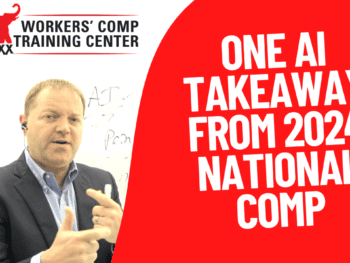This Is Part 3 in a 3 Part Mini Series.
The Tipping Point in Workers Compensation
- Paul Revere, Workers Compensation, and the Tipping Point
- Make Your Work Comp Message Stick Like Gorilla Glue
- How Work Comp Can Be Just Like Prison
Click Link to Access Free PDF Download
Hello, I’m Michael Stack with Amaxx. This is the third part of the three part mini series on the tipping point in Worker’s Compensation. It’s really a study of the lessons and the teachings of Malcolm Gladwell in the book The Tipping Point: How Little Things Can Make a Big Difference. When you’re trying to implement change, when you’re trying to start an epidemic of proper work comp management at your organization.
The Power of Context & The Stanford Prison Experiment
In this third part of the series I want to talk about what I think is really the most interesting part of his lessons, which is the power of context. How the situation, how the environment that you’re in can often impact our actions in a way that’s different than what would normally happen. This is dramatically displayed in the book by a study from 1970s by Stanford University.
What they did was, they created a mock prison. They wanted to understand how that environment was going to impact the behavior of what they deemed as normal men. They had seventy-five people apply and twenty-one were selected to participate in this study. Half of the became guards, half of them became prisoners. I’m going to read you a short passage of what happened in this study.
It says that, “What we were unprepared for was the intensity of the change and the speed at which it happened. The guards were making the prisoners say to one another they loved each other and making them march down the hallway in handcuffs with paper bags over their heads. ‘It was completely opposite from the way I conduct myself now,’ a guard remembers. ‘I think I was positively creative in terms of mental cruelty.'”
“After thirty-six hours, one prisoner began to get hysterical and had to be released. Four more had to be released because of extreme emotion depression, crying, rage and acute anxiety. They had originally intended the experiment run for two weeks but they called it off after six days. ‘I realize now,’ one of the prisoners said, ‘That no matter how together I thought I was inside my head, my prisoner behavior was often less under my control than I realized.'”
FREE DOWNLOAD: “Step-By-Step Process To Master Workers’ Comp In 90 Days”
Situation & Environment Dramatically Impact Behavior
I think that’s an extremely powerful study and very interesting story of how that situation of the prison impacted the behavior of those twenty-one, normal men. Now compare that to your work comp management. When an injured employee is out of work, they often report that they feel like they’re exiled. They feel like the black sheep. How is that situation now going to impact their behavior? Maybe making them do things that they otherwise wouldn’t normally do, causing that claim to be a lot more expensive, and causing a much more poorer outcome for that individual.
Maybe the environment at your organization is really one of tension. It’s one of anxiety. It’s one of challenge that’s going to create your employees to do a fraudulent act that they wouldn’t normally do. Remember the power of context and how that can impact the behavior of your employees, and impact the cost of your worker’s compensation management program.
I’m Michael Stack with Amaxx and this was The Tipping Point in Worker’s Compensation Mini Series. Remember the three elements that Mr. Gladwell talks about in his book. The law of the few. Leveraging those influencers in your company to get by in with your organization. The stickiness factor. How memorable your message is when you’re trying to get your claims reported at that critical time of injury, that message needs to be remembered and acted on. Finally, the power of context and how that can impact the behavior of your employees. Remember, your success in worker’s compensation is defined by your integrity.
Author Michael Stack, Principal, COMPClub, Amaxx LLC. He is an expert in workers compensation cost containment systems and helps employers reduce their work comp costs by 20% to 50%. He works as a consultant to large and mid-market clients, is co-author of Your Ultimate Guide To Mastering Workers Comp Costs, a comprehensive step-by-step manual of cost containment strategies based on hands-on field experience, and is founder of COMPClub, an exclusive member training program on workers compensation cost containment best practices. Through these platforms he is in the trenches on a working together with clients to implement and define best practices, which allows him to continuously be at the forefront of innovation and thought leadership in workers’ compensation cost containment. Contact: mstack@reduceyourworkerscomp.com.
©2016 Amaxx LLC. All rights reserved under International Copyright Law.
Do not use this information without independent verification. All state laws vary. You should consult with your insurance broker, attorney, or qualified professional.
FREE DOWNLOAD: “Step-By-Step Process To Master Workers’ Comp In 90 Days”















Workers Compensation is a bad bill of goods sold to employees who are being promises to get 2/3rd income while staying home with your children or early retirement for older employees. What no one seems to warn these individuals is that: Untaxed income reduces SSI if you do not work those last few years prior to retirement, and since work comp doctors can’t be sued for malpractice, even when performing unnecessary or wrong surgeries, these employees can end up maimed and disabled that had nothing to do with their job. Its worse than prison. There is no protection against providers who exaggerate or give profit driven diagnosis’.